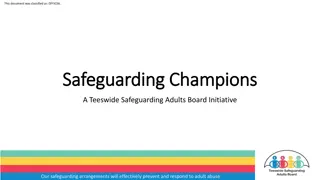Challenges in Higher Education: Safeguarding Student Interests (THESIS) - January 2019 Report
This report discusses the challenges faced by higher education institutions, focusing on enrollment declines and the need for effective risk management strategies. Key points include identifying the extent of the problem, enhancing monitoring processes, and engaging college boards in risk awareness. The report also highlights the potential impact of declining high school graduates on enrollment in the near future.
Download Presentation

Please find below an Image/Link to download the presentation.
The content on the website is provided AS IS for your information and personal use only. It may not be sold, licensed, or shared on other websites without obtaining consent from the author. Download presentation by click this link. If you encounter any issues during the download, it is possible that the publisher has removed the file from their server.
E N D
Presentation Transcript
Transitions in Higher Education: Safeguarding the Interests of Students (THESIS) Working Group Final Report & Recommendations January 2019
MEMBERS BHE Co-Chairs: PARTNERS Chair Gabrieli and DHE Commissioner Santiago EY - Parthenon provided pro bono team for summer providing research and analyses on first two questions Robert Antonucci past MA Commissioner for Education; past President of Fitchburg State; past AG- installed President of troubled higher ed that successfully merged NEASC/NECHE regional accreditor collaborated throughout Alex Cortez Member, BHE; partner, NewProfit; Attorney General s Office in dialogue throughout Katherine Craven CA&FO, Babson; past head of MA School Building Authority and also of UMass Building Authority PROCESS Matt Hills private equity investor and mgmt. consultant; past President, Newton School Committee Core working group at DHE led by Gabrieli/Santiago including legal, financial met weekly since May Ranch Kimball past partner BCG; past Secretary of Econ Development; past Chair of Board of Wheelock College through its merger with BU Parthenon phase over summer met weekly Paul Mattera Member, BHE; Board Chair Salem State; Select Working Group members in ad hoc dialogues Gabby King Morse ED, uAspire Massachusetts (leading nonprofit in college affordability) Full Working Group met four times 2
Initial Charge: Four Questions What is the nature and extent of the problem? Are there current measures and monitoring processes that effectively track and manage risk? How can we engage college Boards more in risk awareness and mitigation? What could DHE do about undermanaged risk? 3
1. Pressures on higher education Enrollment declines are likely to continue to disproportionately affect small schools NATIONAL Enrollment* trends by size for all degree-granting institutions, FY11-FY17 MASSACHUSETTS Enrollment* trends by size for all degree-granting institutions, FY11-FY17 *Enrollment includes both graduate and undergraduate, public and private Note: Buckets are based on 2010 enrollment (not fluid buckets); only institutions with non-zero enrollment in both 2010 and 2016 were considered Source: IPEDS 4
1. Pressures on higher education The problem could be exacerbated with the upcoming dip in enrollment likely to result from the falling number of high school graduates Total public and private high school graduates in the United States and Massachusetts, indexed to 2005 2000-2031F Nationwide birthrates peaked just before the recession at 14.3 per 1,000 people in 2007, dropping by 13% to the trough in 2030 H F Great Recession Birthrate dip MA graduates peaked in 2012, declining by 11% to the trough projected for 2030 Note: Birth rate is calculated as number of births per 1,000 people Source: Western Interstate Commission for Higher Education: Knocking at the College Door: Projections of High School Graduates, December 2016; The World Bank 5
1. Pressures on higher education Of the remaining private institutions in MA, a substantial number show problematic financial health across multiple measures, with growing risk Revenue growth not keeping pace with expense growth Low Forbes financial grades Declining enrollment 24% of institutions 34% of institutions 30% of institutions 24% of MA private nonprofit 4-year institutions saw decreases in enrollment by over 10% between 2011 and 2016, up from 8% of institutions during the prior 5 year period 30% of MA private nonprofit 4-year institutions with Forbes financial health grades received a 1.75 GPA or below in the 2017 report, up from 24% in 2014, the earliest available scores 34% of MA private nonprofit 4-year institutions saw expenses increase by 5pp or more above revenues in 2016 compared to 2011 Increase in low US Dept. of Ed (USED) financial responsibility scores Declining US Dept. of Ed financial responsibility scores 14% of institutions 31% of institutions 31% of MA private nonprofit 4-year institutions saw a decline in average DOE score in the 5 year period ending 2016 versus the 5 year period ending 2011 14% of MA private nonprofit 4-year institutions received DOE score of 1.5 or below in 2016 versus 9% in 2011 Note: Forbes financial grades are based on endowment assets per FTE, primary reserve ratio, viability ratio, core operating margin, tuition as a percentage of core revenues, return on assets, admission yield, percent freshman getting institutional grants, and instruction expenses per FTE; MA private nonprofit 4-year institutions include Baccalaureate Colleges, Master s Colleges and Universities, Research Universities, and Specialty Schools from the Carnegie Classification system; Revenue includes temporarily restricted assets, graduate revenue, private gifts, and other revenue as defined by IPEDS Source: Moody s; IPEDS; Forbes; US Department of Education 6
Slightly more than half of the 4-year private nonprofit undergraduate institutions in Massachusetts saw a decline in their Forbes financial score Forbes College Financial GPA, 4-year private nonprofit undergraduate institutions in MA, 2014 v. 2017 2014 = 2017 4.5 2017 Forbes College Financial GPA Schools above the line saw an increase in Forbes rating from 2014 to 2017 4.0 3.5 3.0 2.5 2.0 1.5 1.0 Schools below the line saw a decrease in Forbes rating from 2014 to 2017 0.5 0.0 0.0 0.5 1.0 D 1.5 D+ 2.0 C 2.5 C+ 3.0 B 3.5 B+ 4.0 A 4.5 A+ 2014 Forbes College Financial GPA EY-Parthenon | Page 7 Source: Forbes College Financial Grades
THESIS Working Group Findings Questions Recommendation ratified by THESIS Working Group that The risk of further challenges to viability at non- profit institutions of higher education (NPIHEs) leading to potential student disruption is significant, ongoing and likely growing. Question 1 Recommendation ratified by THESIS Working Group that Current standard financial metrics are insufficient for timely or fully identifying at-risk NPIHEs and current processes among the triad of accreditors, USED and state authorities are insufficient to ensure prevention/mitigation of future unacceptable disruption to students and others. Question 2
2. Oversight and metrics The state and accreditors utilize the DOE score as one metric, which often fails to give stakeholders adequate notice of financial problems DOE Scores 1-2 years before closure suggested financial issues in only 50% of cases Financially Distressed* and Probationary IHEs Sample of Previously Closed IHEs Saint Joseph s College, IN Memphis College of Art, TE Saint Grace University, NE Mount Ida College, MA Marylhurst University*, OR Coleman University, CA College of St. Joseph, VT Newbury College, MA Dowling College, NY Augustine s University, NC February 2017 October 2017 October 2017 May 2018 Date Closed April 2018 July 2018 June 2016 Still open Still open Still open 2016 DOE Score Already closed 1.4 0.6 2.1 2.1 2.2 1.2 2.1 2.2 1.7 2012 DOE Score 2.2 2.1 2.1 1.5 2.8 3.0 1.3 2.8 2.6 2.6 The DOE score four years before closure rarely suggested issues, which is crucial as this is when students are making their college choice DOE Financial Responsibility Composite Score -1.0 to 0.9 1.0 to 1.4 1.5 to 3.0 Not financially responsible Flagged for monitoring Financially responsible Note: Saint Augustine s University was recently put on probation by accreditors Source: IPEDS; Inside Higher Education, Too Late for a Fix?, August 8, 2018 9
Summary of Proposed Process Active Monitoring Annual North Star INTERVENTION INTERVENTION ALL MA NPIHE s Active Monitoring Student Notification Contingency Plan Through improved financial health NPIHE s can exit monitoring Annual Screening Annual North Star 10
Guiding Principle for DHE Proactive Monitoring and Action with At-Risk Non-Profit Institutions of Higher Education If by December 1st of any school year, the IHE has significant risk, as reasonably determined by DHE, of not having the financial capability to complete the current school year and the subsequent one, a full contingency transfer/teachout plan must be completed and approved by DHE and students must be notified of the IHE s financial condition and risk North Star 11
The proposed DHE North Star requirement is well within broader accreditation standards The proposed eighteen month North Star requirement would only require the institution to have the financial capability to complete the current school year and the subsequent one Dec. June Current Year +1 Current Year +2 Current Year +3 Current Year +4 Current Year Sophomore Class Freshman Class Entering Class Senior Class Junior Class The New England Commission of Higher Education s (NECHE) 7th standard for accreditation is called Institutional Resources which requires that the The institution demonstrates, through verifiable internal and external evidence, its financial capacity to graduate its entering class 12























